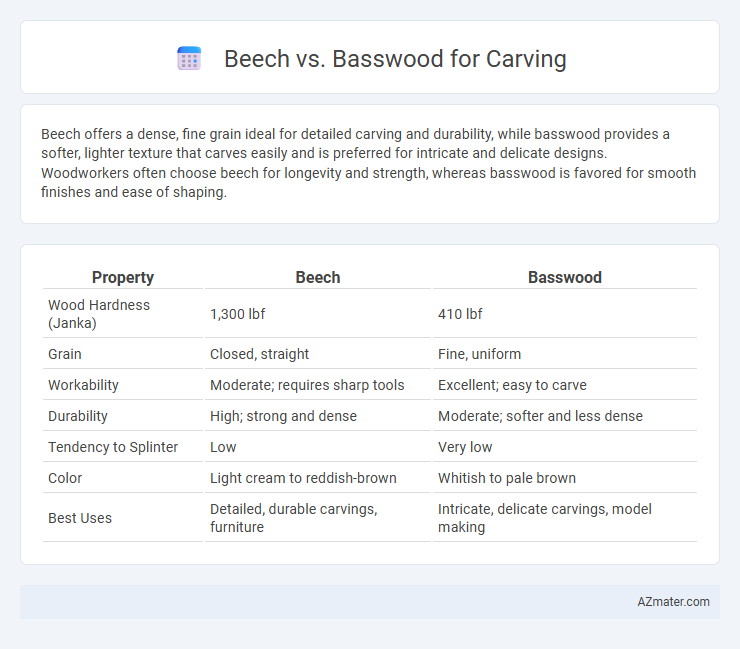Beech offers a dense, fine grain ideal for detailed carving and durability, while basswood provides a softer, lighter texture that carves easily and is preferred for intricate and delicate designs. Woodworkers often choose beech for longevity and strength, whereas basswood is favored for smooth finishes and ease of shaping.
Table of Comparison
| Property | Beech | Basswood |
|---|---|---|
| Wood Hardness (Janka) | 1,300 lbf | 410 lbf |
| Grain | Closed, straight | Fine, uniform |
| Workability | Moderate; requires sharp tools | Excellent; easy to carve |
| Durability | High; strong and dense | Moderate; softer and less dense |
| Tendency to Splinter | Low | Very low |
| Color | Light cream to reddish-brown | Whitish to pale brown |
| Best Uses | Detailed, durable carvings, furniture | Intricate, delicate carvings, model making |
Introduction: Beech vs Basswood for Carving
Beech wood offers a dense, hard texture that holds fine details well, making it suitable for intricate carving projects requiring durability. Basswood provides a lightweight, softer grain that carves easily with less effort, ideal for beginners and detailed relief work. Both woods are popular choices among carvers, with beech favored for strength and basswood preferred for ease of shaping.
Wood Characteristics Overview
Beech wood features a tight, fine grain that provides excellent durability and resistance to wear, making it ideal for detailed carving projects that require precision and strength. Basswood is softer, with a uniform texture and minimal grain patterns, which allows for easier carving and smoother cuts, preferred by beginners and intricate designs. Both woods offer stability and minimal warping, but beech's hardness contrasts with basswood's lightweight softness, influencing the choice based on project complexity and tool use.
Density and Hardness Comparison
Beech wood typically has a density of around 720 kg/m3 and a Janka hardness of approximately 1,300 lbf, making it a dense and hard material suitable for detailed and durable carvings. Basswood, on the other hand, has a lower density near 410 kg/m3 and a Janka hardness around 410 lbf, providing a softer, lighter option that carves easily with less effort. The higher density and hardness of beech result in a more wear-resistant finish, while basswood's softness allows for finer, more intricate cuts without tool fatigue.
Workability and Ease of Carving
Beech wood offers a fine, consistent grain that provides moderate hardness and durability, making it suitable for detailed carving but requiring sharper tools and more effort. Basswood is favored for carving due to its soft texture and even grain, allowing for smooth, precise cuts and easier handling by both beginners and experienced carvers. The superior workability of basswood reduces tool wear and fatigue, promoting cleaner lines and intricate designs compared to the denser beech.
Grain Structure and Texture
Beech wood has a tight, straight grain structure with a fine, uniform texture, making it ideal for detailed carving and smooth finishes. Basswood features a softer, more open grain with a fine, even texture that allows for easy cutting and minimal resistance, perfect for beginners and intricate work. Both woods offer consistency, but beech provides greater durability while basswood excels in ease of shaping and minimal tool wear.
Detailing and Finish Quality
Beech wood offers a tight, fine grain that allows for precise detailing in carving, resulting in sharp, well-defined edges ideal for intricate designs. Basswood is softer and more pliable, making it easier to carve but sometimes leading to less crisp details and a smoother finish. Finishing Beech typically yields a polished, durable surface, while Basswood accepts paint and stain evenly, enhancing overall aesthetic versatility.
Availability and Cost
Beech is widely available and generally more affordable than basswood, making it a popular choice among carvers on a budget. Basswood, while slightly more expensive, is prized for its fine grain and softness, leading to easier carving and finer detail work. Both woods are commonly found in craft stores and online, but beech's greater abundance often results in lower prices.
Best Uses for Beech in Carving
Beech is highly valued for carving due to its fine, even grain and hard, dense texture, which provides excellent durability and precision in detailed work. Its resistance to splitting and smooth finish make it ideal for furniture carving, kitchen utensils, and intricate sculptural pieces. Compared to basswood, beech is better suited for projects requiring strength and a polished surface, while basswood is preferred for easier cutting and softer textures.
Best Uses for Basswood in Carving
Basswood is favored in carving due to its soft texture, fine grain, and minimal resistance, making it ideal for detailed work and intricate designs. Its uniformity and lightweight nature allow for smooth cuts and easy shaping, especially suited for beginners and precise figurative sculptures. Compared to beech, which is harder and denser, basswood remains the preferred choice for relief carving, whittling, and crafting delicate wooden components.
Conclusion: Choosing the Right Wood for Your Project
Beech offers a fine, tight grain and greater hardness, making it ideal for detailed, durable carving projects. Basswood's soft texture and even grain provide easier carving for beginners and smoother finishes on intricate designs. Select Beech for strength and longevity in tools or decorative pieces, while Basswood suits delicate, detailed work and educational projects.

Infographic: Beech vs Basswood for Carving
 azmater.com
azmater.com